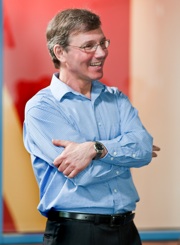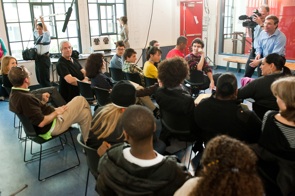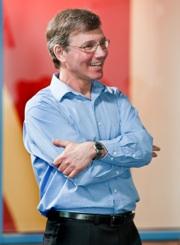Rob Kapilow drew a freehand silhouette of the Golden Gate Bridge on a blackboard — “with the latticework” — and invited the crowd at the Dennis Gallagher Arts Pavilion in the International High School arts and music building off Market Street in San Francisco to sing along: to sing the Bridge.

Photos by Stuart Lirette
Kapilow, commissioned by Marin Symphony to compose Golden Gate Opus, a piece for orchestra, chorus, and recorded natural sound to celebrate the Bridge’s 75th anniversary next year, has been meeting with local school and community groups since January to ask “What does the Bridge sound like?” and listen to the answers.
The answers — the entire meetings — have been filmed for a documentary on the process, the celebration, and the composition itself.
That morning Kapilow had sailed under the span on the historic scow Alma, from the Maritime Museum. The late-afternoon get-together at the Gallagher Pavilion last Tuesday was his final one before returning to New York. But he exhorted his audience to stay in touch, giving out his personal email address.
The audience, hosted by David Williamson of International High School, included guests from the Smuin Ballet, the San Francisco Arts Commission, the San Francisco Day School, the San Francisco Convention and Visitors Bureau, and broadcasters like Hoyt Smith of KDFC.
There were also music students from the IHS, some carrying their instruments, “and I think I saw some of the SFJAZZ All-Stars there, in back,” said Kerry Faith Weddington, Marin Symphony’s engaging project manager for Golden Gate Opus.
Responses From an Eager Audience
Engagement was the word for Tuesday’s meeting and the MO for the Opus project. Kapilow, ever smiling, constantly upbeat, directed a barrage of questions at the eager-to-connect audience, reformulating and turning around everything they said, in order to garner more responses.

And they ate it up. At times, it seemed more like a pep rally for Golden Gate Opus and the Bridge itself, rather than research, or just community feedback. “Community Call and Response” would be more like it.
Whimsically, Kapilow recalled an old news story he read in which the reporter asked one of the planning engineers how long the Bridge would last. “Forever” was the reply. “And how long is forever?” the reporter riposted.
“Incredible, the tenacity the planners had, to go through all those years,” said Kapilow. “The victory of Yes over No ... I have no idea how to include that in the piece. Does anybody have an idea?”
“Maybe something simple would express that,” suggested a student. “Like cello versus trombone?”
“... And they’d come together towards the end!” answered Kapilow.
Another opined, “Maybe go C-major scale to a minor scale ... ?”
“Victory of major over minor!” Kapilow shot back.
Human Sorrow on an Engineering Marvel

The iconic contours of the Bridge, the “spaces between bars so you can see out — but because of that, there’s the possibility of suicide,” inspired a discussion of the Bridge as a magnet for suicides. Two students spoke of interviewing survivors of Bridge jumps, one as a middle school journalism student, calling the experience “powerful.” Kapilow spoke of meeting for hours with families of suicide victims, who agreed to share suicide notes, one of which read: “I am broken.”
“It seemed to call out to be set to music,” he said, speaking also of the 60-voice Marin Symphony Chorus, and of the concrete sound he would use, for the first time in his career, with the help of archivist Claudia Nakagi and Fred Newman, a radio “sound effects guy” from A Prairie Home Companion. From bird sounds at Alcatraz, to the lowing of foghorns, to “I Am Broken.”
Tuesday’s meeting was just one of many, including others with workers on the Bridge, residents at a retirement community in Central Marin, and children at a school in Marin City. Weddington recalled the students in Marin City, who treated the convocation at first with a blasé attitude, then opened up with enthusiasm. “They’re the closest group living on this side of the Bridge,” Weddington said. “The give-and-take was fantastic. All jumped into the process. All had a voice.”
“I think Rob’s closer to hearing the piece come together,” she said. “He starts composing it June 1, to be finished at the end of October. From then on, it’ll be outreach, not so much gathering as sharing.”
Kapilow, who’s spent the past 15 years in residence at Lincoln Center with his "What Makes It Great?" events and Family Musik series, counts Golden Gate Opus as one of his “city pieces.” Reminding himself to go to the Wave Organ in the San Francisco Marina — “I hadn’t heard about that!” — he looked back on years of working with communities to come up with the material for compositions.
“It always strikes me how engaged people are,” he said. “They say the only thing people like less than classical music is new classical music, but this is thrilling to watch. Suggestions from meetings like this tell me what to listen to. This, today, was the piece — people rethinking the Bridge!” (Note: Kapilow and Marin Symphony invite the public’s suggestions through June 1 on their Facebook site: Golden Gate Opus, or by email to [email protected].)

